Papers by Johildo Barbosa

A área de pesquisa se situa no Cráton do São Francisco, no sul da Bahia, Brasil. Nessa região, no... more A área de pesquisa se situa no Cráton do São Francisco, no sul da Bahia, Brasil. Nessa região, no segmento crustal Bloco Itabuna-Salvador-Curaçá (BISC), ocorrem rochas supracrustais associadas a gnaisses tonalíticos/trondhjemíticos a monzoníticos e rochas máficas subordinadas, de idades arqueana e paleoproterozoica, todos fortemente deformados e reequilibrados na fácies granulito em 2,07 a 2,08 Ga. As rochas supracrustais incluem granulitos com safirina constituídos por quartzo, ortopiroxênio, silimanita, granada, mesopertita, plagioclásio, biotita e cordierita. Com base nos arranjos microestruturais entre os minerais constituintes dos granulitos com safirina, a paragênese de pico metamórfico é Grt1 + Opx1 + Bt1 + Qtz + Sil1 + Spr1 + Mp. Microestruturas de reações entre minerais, como coroas de simplectitos ao redor de porfiroblastos, permitiram identificar as seguintes paragêneses retrógradas, interpretadas como formadas durante a ascensão tectônica dessas rochas: Grt1 ± Qtz = Opx2...
The Salvador-Esplanada-Boquim Belt (SEBB) is considered a branch of the São Francisco Craton, loc... more The Salvador-Esplanada-Boquim Belt (SEBB) is considered a branch of the São Francisco Craton, located in its northeastern portion, in the Brazilian states of Bahia and Sergipe. This paper analyzed the U-Pb (LA-ICP-MS) geochronology on the Gneissic-Migmatitic Complex (GMC) zircons in the rocks of the SEBB. Six analyses were made on the rocks of GMC and two on granitic dykes. The obtained data allowed concluding that the GMC rocks were formed between 2150 ± 19-2188 ± 30 Ma, while the dykes had their crystallization in line with the process of regional metamorphism in 2073 Ma. These metamorphic evens are interpreted as products of the collision with the Serrinha

Resumo: O Corredor do Paramirim representa a zona de máxima inversão do aulacógeno homônimo e eng... more Resumo: O Corredor do Paramirim representa a zona de máxima inversão do aulacógeno homônimo e engloba dois cinturões de cavalgamentos e dobramentos de vergências opostas. Os mesmos acham-se expostos na serra Espinhaço Setentrional e na Chapada Diamantina, separados por rochas do embasamento arqueano/ paleoproterozoico e pelo Complexo Lagoa Real, com idade de 1,75 Ga. Esse Complexo compreende o sienito São Timóteo e os ortognaisses adjacentes, além de albititos, epidositos e oligoclasitos, localmente mineralizados em urânio. Anfibolitos ocorrem como enclaves deformados dentro dos ortognaisses. Tais rochas hospedam-se em zonas de cisalhamento compressionais de idade brasiliana. Na altura da cidade de Caetité, Bahia, essas zonas de cisalhamento foram responsáveis pela colocação desse Complexo sobre as unidades do embasamento e essas sobre os metassedimentos do Supergrupo Espinhaço. Os dados químicos de elementos maiores do sienito e dos ortognaisses revelaram que essas rochas são pobre...

Geologia USP. Série Científica
TIMS Pb-Pb geochronological data allow determination of the timing and genesis of the Fazenda Coq... more TIMS Pb-Pb geochronological data allow determination of the timing and genesis of the Fazenda Coqueiro volcanic‑hosted massive sulfide (VHMS) Zn-Pb deposit hosted in the Neoarchean Mundo Novo greenstone belt (MNGB), NE São Francisco Craton. The deposit is inserted in the Rhyacian-Orosirian Contendas-Jacobina lineament between Archean cratonic blocks. The basement of the deposit is composed of Paleoarchean metagranite and metarhyolite nuclei tectonically emplaced within the supracrustal rocks. The volcanic-sedimentary rocks comprise the ocean floor western metabasalt, calcsilicate rock, aluminous schist, metachert, banded iron formation, and tremolitite of the middle sequence and metasedimentary siliciclastic rocks of the uppermost sequence of the MNGB. The western metabasalt is hydrothermally altered, which resulted in the formation of two alteration zones. They consist of carbonate zone, proximal, hosting massive sulfides composed mainly of sphalerite and galena with minor chalcopy...
Revista Brasileira de Geociências

Revista Brasileira de Geociências
PETROGRAPHIC AND METAMORPHIC CHARACTERIZATION OF THE ARCHEAN/ LATE-PROTEROZOIC GRANULITES OF THE ... more PETROGRAPHIC AND METAMORPHIC CHARACTERIZATION OF THE ARCHEAN/ LATE-PROTEROZOIC GRANULITES OF THE REGION OF ITABUNA-B AMI A. The Archean/Lower Proterozoic high-grade rocks ofthe Itabunaregion in southern Bahia were separated into five assemblages. The first one was named Ilhéus Complex, being formedby intercalationsofbasic granulites with hornblende and felsic granulites with plagioclase. The second, São José Complex, is composed of intermediate to basic granulites with intercalations of garnet bearing basic granulites. The third, Ibicarai r BueTarema Complex is formed essentially of intermediate granulites and a fourth assemblage that comprises the Água Sumida (metamonzonites), Rio Paraíso (meta-syenites)and São Geraldo granitoids (this latter one of granitic composition). All the rocks ofthe former four assemblages are ofthe granulite facies of metamorphisrn. The fifth and last assemblage was named Rio Japu, being formed mostly of biotite and hornblende gneisses readjusted to the amphibolite facies conditions. Besides the amphibolite and granulite progressive facies the paragenetic and textural studies ofthe metamorphic reactions and mineral chemistry allowed to recognize the granulite, amphibolite and greenschist regressive facies in the area. The temperatures and pressure values for the maximum metamorphism were estimated in 6 kbar and 850°C. The geotectonic model forthe area is in agreement with the one interpreted for a northern area. In that place is taken into account the existence of a subduction zone closer to the Atlantic coastal zone and, an arc or a series of island arcs as one moves inboard the continent.
Revista Brasileira de Geociências
... granulação média a grossa e uma coloração cinza-escura, sendo caracterizados mineralogi-camen... more ... granulação média a grossa e uma coloração cinza-escura, sendo caracterizados mineralogi-camente pela presença de plagioclásio antipertítico e biotita, ambos em equilíbrio com os clino e ortopiroxênios, que são também relativamente abundantes na rocha (Barbosa 1986). ...

Brazilian Journal of Geology
Field, petrological and LA-ICP-MS U-Pb geochronological data of metavolcanic rocks were used to i... more Field, petrological and LA-ICP-MS U-Pb geochronological data of metavolcanic rocks were used to interpret the petrological processes and to propose the tectonic setting for the Mundo Novo greenstone belt (MNGB) in the eastern São Francisco Craton. The metavolcanic rocks studied are metakomatiite, eastern and western metabasalts, and metadacite with subordinate metarhyolite, which host ocean floor hydrothermal alteration zones and are covered by ocean floor lithological associations composed of chemical metasedimentary rocks. Fractional crystallization and heterogeneous intraoceanic contaminations explain the mineralogical differences between the two metabasalts and the high (La/Yb) N ratio values of metakomatiite and metadacite. The metakomatiite and the eastern and western metabasalts feature a vector from the MORB-OIB array to the volcanic arc array in the Nb/Yb-Th/Yb diagram, similar to the Archean intraoceanic arc-basin systems. The geochemical pattern of the eastern and western metabasalts in the Zr-Zr/Y diagram suggests volcanism in nearby island arc and backarc basin settings, respectively. The 2595 ± 21 Ma U-Pb zircon crystallization age of the metadacite allowed the determination of the timing of volcanism in the MNGB. Therefore, an intraoceanic provenance in an arc-basin system is proposed for the MNGB in the Neoarchean, which was later compressed between cratonic blocks during the Rhyacian-Orosirian event.

Geologia USP. Série Científica
O Cinturão Salvador-Esplanada-Boquim (CSEB) é provavelmente um ramo nordeste do Orógeno Itabuna-S... more O Cinturão Salvador-Esplanada-Boquim (CSEB) é provavelmente um ramo nordeste do Orógeno Itabuna-Salvador-Curaçá. Neste trabalho, inédito para a região, é apresentada a caracterização petrográfica, petroquímica e geocronológica preliminar das rochas granulíticas da porção central-norte desse cinturão, onde foram separadas quatro unidades granulíticas ácidas e intermediárias, além de bandas de granulitos máficos, granulitos aluminosos e quartzitos. As quatro unidades ácidas e intermediárias são ortogranulitos foliados onde os granulitos máficos encontram-se encaixados sob a forma de lentes. Essas rochas foram atravessadas por diques orosirianos, dacíticos-riolíticos (Diques de Arauá). O estudo litogeoquímico dos granulitos ácidos e intermediários revelou quatro séries cálcio-alcalinas de baixo a alto K, assim denominadas: enderbítica (Ed1), enderbítica (Ed2); charnockítica de composição monzogranítica (MCh) e charnoenderbítica (Ch-Ed). Diagramas multielementares indicam que as quatro ...

Revista Brasileira de Geociências
PETROGRAPHY AND PETROCHEMISTRY OF THE GRANULITES FROM THE ITABUNA REGION-BAHIA. The Early Protero... more PETROGRAPHY AND PETROCHEMISTRY OF THE GRANULITES FROM THE ITABUNA REGION-BAHIA. The Early Proterozoic rocks of Itabuna region, southern Bahia, were separated into four main groups. The first one, the Ilhéus Complex (IC) is formed by bands of basic granulites with hornblende plus pyroxenes and mostly intermediate granulites (andesites and/or quartz diorites), these last ones with a high potassium calc-alkaline tendency. The second, the São José Complex (SJC) is essentially composed of basic (andesitic basalts and/or diorites) and intermediate granulites (andesites and/or quartz diorites) of low potassium calc-alkaline affiliation, but which include bands of garnet-bearing basic granulites (basalts and/or gabbros) of ocean floor or back-arc basin tholeiitic composition. The third group, the Ibicaraí-Buerarema Complex (IBC), and Rio Japu Complex, is made up mostly by intermediate granulites (andesitic basalts and/or diorites, andesites and/or quartz diorites, and dacites and/or tonalites) and acid granulites (rhyolites and/or trondhjemites), also with low potassium calc-alkaline tendency and which also exhibit bands of basic (basalts and/or gabbros) tholeiitic granulites of ocean floor or back-arc basin character. The fourth group is formed by plutonic bodies (monzodiorites, monzonites, syenites and granites) possibly derived from shoshonitic/alkaline magmas. These granulites may be correlated with those which occur to the north, where they before collision/obduction/deformation/metamorphism processes, as derived from a subduction zone near the Atlantic coastal region are considered, that generated arc/back-arc basin or active continental margin environments in the southeastern Bahia, during the Early Proterozoic.
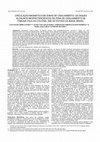
Revista Brasileira de Geociências
Fluid migration in shear zones is a difficult feature for three-dimensional reconstruction. One o... more Fluid migration in shear zones is a difficult feature for three-dimensional reconstruction. One of the most complex problem is to find a single area that combines at the same time rheological and structural aspects. In southeastern Bahia State, Brazil, Neoproterozoic alkaline felsic and mafic dykes of the Itabuna-Itaju do Colônia Dyke Province were emplaced along the N45°-trending Itabuna-Itaju do Colônia Shear Zone. They offer a rare opportunity to study magmatic circulation coeval to the tectonic activities of a shear zone. Altogether 524 dykes were examined. In 60 of them reliable markers of magmatic flow sense could be found. When the flow Hneations are plotted on a map, tridimensional flow patterns begin to appear. Two patterns can be easily highlighted: (i) a regular straight, parallel or sub-parallel to the main shear zone, with alternating NE and SW flow sense, related to the shear zone tectonic control and (ii) a radial, with divergent magmatic flow sense, indicating that production of the fracture-conduits were controlled by magmatic overpressure. On the basis of the radial and regular straight patterns and magmatic flow trails, it can be suggested: (i) locations of the alkaline felsic and mafic sources in subsurface and within the shear zone and (ii) explanations for felsic and mafic alkaline magma mixing phenomena observed on a regional scale.

Revista Brasileira de Geociências
IICSZ is located in SSE of the Bahia State, Brazil, in the eastern border of the Sao Francisco Cr... more IICSZ is located in SSE of the Bahia State, Brazil, in the eastern border of the Sao Francisco Craton, near the Brasiliano Marginal Fold Belt of Aracuaf. The IICSZ is oriented N45° and affects an area of about 4500km. On its southwestern geographic prolongation it is cut by another shear zone oriented N130°, the Potiragua Shear Zone. In the IICSZ there are three groups of sheet-like bodies with different characteristics: (i) a Paleoproterozoic (≅2.0 Ga-old) amphibolite dyke group, (ii) a Meso-Neoproterozoic (1.0 Ga-old) tholeiitic mafic dyke swarm and (iii) a Neoproterozoic (0.65-0.45 Ga-old) alkaline felsic and mafic dyke swarm of the Itabuna-Itaju do Colônia Province geologically associated with the Alkaline Province of the South of the Bahia and with the IICSZ. Herein it was applied three different methods to understanding the IICSZ dynamic evolution: (i) comparison among real structural lineament and hypothetical similar patterns obtained through geometric modeling; (ii) structural field data and (iii) field measurements of alkaline dyke emplacement plan. The result showed that the tectonic history of IICSZ started with a sinistral transcurrent movement, result of a N-S compressive motion, followed by dextral-sinistral transcurrent oscillations and ended with a dextral phase, as a result of E-W compression. Besides these facts, field observations reveal that the felsic fissural alkaline magmatism was a little older than the mafic one. One the other hand, the fact that the felsic dykes were only mildly affected by the sinistral wrench movement implies a late-tectonic emplacement and a maximum of magmatic volume emplacement during the dextral transcurrent activity. Keywords: Geotectonic, dyke emplacement, shear zones and alkaline rocks RESUMO A Zona de Cisalhamento de Itabuna-Itaju do Colônia-ZCIIC encontra-se localizada no SSE do estado da Bahia, Brasil, dentro da borda leste do Cráton do São Francisco e próxima à Faixa Marginal de Dobramentos brasilianos Araçuaí. Apresenta uma orientação N45° e afeta uma área em torno de 4500km. A sua extremidade S W é cortada por outra zona de cisalhamento orientada N140°, a Zona de Cisalhamento de Potiraguá. Dentro da ZCIIC podem ser encontrados três grupos de rochas tabulares com características peculiares: (i) um grupo de diques anfibolíticos paleoproterozóicos; (ii) um enxame de diques tholeiíticos de idades próximas a 1.0 Ga e (iii) um enxame de diques alcalinos félsicos e máficos neoproterozóicos, 0.65-0.45 Ga, da ProvínciaFiloniana de Itabuna-Itaju do Colónia, intimamente associados à Província Alcalina do Sul da Bahia e à própria ZCIIC. Para se estabelecer a evolução dinâmica desta zona de cisalhamento, foram utilizados três tipos de metodologias de análise: (i) comparação dos lineamentos foto-interpretados com padrões similares hipotéticos obtidos por modelagem geométrica, (ii) dados estruturais obtidos no campo e (iii) controle dos planos de colocação dos diques alcalinos cronocorrelatos. Como resultado disto pôde ser observado que a história tectônica da ZCIIC começou com uma transcorrência sinistrai, resultado de uma compressão próxima à N-S, que foi seguida por uma fase de oscilação dextral-sinistral e finalizada por uma fase francamente dextral, resultado de uma compressão próxima à E-W. Além disto observações de campo levam a crer que o magmatismo fissural alcalino félsico foi ligeiramente mais antigo que o máfico, porém o fato de que os diques félsicos se encontram pouco afetados pela dinâmica sinistrai leva a crer que estes filões foram colocados em uma fase tardi-tectônica e que o ápice do magmatismo fissural ocorreu durante a fase dextral. Palavras-chave: Geotectônica, colocação de diques, zonas de cisalhamento e rochas alcalinas.
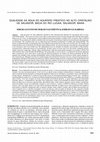
Revista Brasileira de Geociências
The Lucaia river basin is one of the seventeen urban systems of surface drainage of the Salvador ... more The Lucaia river basin is one of the seventeen urban systems of surface drainage of the Salvador municipality. With an area of 14 km 2 , its underground is made of highly fractured metamorphic crystalline rocks, covered by a thick werthered overburden. The crystalline rocks and the overburden form a free aquifer of mixed nature, both intersticial and fissural, inhomogeneous and anisotropic. The crystalline rocks vary in composition from monzonitic-monzodioritic to tonalitic and charnoenderbitic. The former are hydrochemically well defined by their ionic rMg/rCa ratio and the latter by their ionic rCa/rNa ratio. The tonalitic and charnoenderbitic rocks are limited by the Salvador and the Iguatemi faults, whereas the mononitic-monzodioritic rocks predominate to the easternmost side of the studied area. The underground waters are normally Na-chloridic and unusually Ca-Mg-chloridic, characterized by a downward increase of Na-bicarbonate. All these waters are fresh, with a low salt content, containing calcium, sodium, potassium, magnesium, chloride, sulfate and bicarbonate within the normal quality standards, in accordance with the 518/ 2004 technical norm of the Brazilian Health Ministry. The good quality of water, however, is disturbed by the densely populated urban environment, and in many places certain physical-chemical parameters are found to be altered, particularly the pH, the apparent color, turbidity, nitrate, ammonia and phosphate contents, besides the presence of several heavy metals, namely manganese, iron, lead and arsenic. Manganese and iron are of natural origin, derived from the local rocky reservoirs, whereas lead and arsenic are anthropogenic. Biological contamination by total fecal coliforms and heterotrophic bacteriae is widespread. The liquid effluents from the urban and domestic sewage disposal, along with the solid waste (garbage) are the sources for the majority of this contamination. The Lucaia aquifer is open to most of the contamination hazards because it is shallow, and easily exposed to the various forms of anthropic activities, which are able to produce a diversity of pollutants.

Revista Brasileira de Geociências
The Salvador city is located in the Salvador-Esplanada belt, which can be subdivided into three m... more The Salvador city is located in the Salvador-Esplanada belt, which can be subdivided into three major domains: The Recôncavo sedimentary basin, the coastal plain and the Salvador high. The Salvador high can be subdivided into two provinces, separated by the Iguatemi Fault. In the block located to the west of this fault metamorphic rocks in the granulite facies dominate, whereas to the east metamorphic rocks in the amphibolite facies are present. This paper is focused in the western province where it is possible to identify the following rock types: (i) alumino-magnesian granulites, basic granulites and quartzites with garnetorthopyroxene and (ii) orthoderived metamorphic rocks composed of tonalitic and charnoenderbitic granulites, including enclaves of metapiroxenites and metagabbros. Concerning the nature of the protolites, it is assumed that the alumino-magnesian granulites, are restites from the fusion of pelitic rocks, which are usually associated with light-colored garnet bearing granites, considered as the liquids resulting from that fusion. The basic granulites and quartzites with garnet-orthopyroxene associated with the aluminomagnesian granulites are thought to be the product of the metamorphism of basalts and cherts. With respect to the orthoderived protolites, the petrochemistry has shown that the piroxenitic enclaves were derived from Mg-rich tholeiitic magmas and the gabbroic ones have had their origin from either tholeiitic or transitional tholeiitic/calc alkaline magmas. The tonalitic and the charnoenderbitic granulites, were both derived from calc-alkaline low-K and high-K magmas, respectively. The rocks were deformed both in the ductile and brittle states. In the first case, recumbent folds were refolded, originating upright isoclinal folds. In the second case fractures with several orientations were formed. Many of these fractures were filled either with metamorphic and non-metamorphic monzosienogranites and mafic dikes. Same times mixture between mafic and felsic magmas result in commingling structures. Despite the small number of geochronological data it is possible to infer that the granulitic protolytes are archaean (SHRIMP age of ± 2,5 Ga, obtained in the center of a zircon from a tonalitic granulite) and that the granulitization (± 8kbar-850 o C) took place during the paleoproterozoic (SHRIMP age of ± 2,0 Ga, obtained from the periphery of the zircons).

Revista Brasileira de Geociências
Resumo O alto cristalino de Salvador-Bahia tem no seu subsolo rochas cristalinas metamorfizadas e... more Resumo O alto cristalino de Salvador-Bahia tem no seu subsolo rochas cristalinas metamorfizadas e fraturadas, cobertas por um espesso manto regolítico e pela Formação Barreiras, constituindo um aqüífero confinado, heterogêneo e anisotrópico, misto e interdependente, do tipo fissural e intergranular. As águas subterrâneas das coberturas são normalmente cloretadas sódicas enquanto que as mais profundas situadas no embasamento cristalino fissural são bicarbonatada sódica e cálcicas-magnesianas. Todas são águas doces com baixo conteúdo salino, predominando o sódio e o cloreto, devido a influência dos aerossóis marinhos. Os carbonatos aragonita, calcita e dolomita apresentam-se supersaturados nas águas do embasamento cristalino, enquanto que a gibsita apresenta índices de saturação positivos nas coberturas regolíticas. A hematita e a goetita apresentam-se em condições de supersaturação tanto nas coberturas quanto no embasamento fissural produzindo incrustações ferruginosas nos poços tubulares quando perfurados nesses dois ambientes hidrogeoquímicos. O manganês é muito freqüente nas águas subterrâneas da região, ocorrendo dissolvido sob a forma de Mn2+ e em condições de subsaturação tanto nas coberturas quanto no aqüífero cristalino fissural, não havendo, portanto possibilidade de se precipitar sob a forma de pirolusita e manganita.

Revista Brasileira de Geociências
Resumo As Bacias de Camamú e Sul do Recôncavo localizam-se nas proximidades da margem continental... more Resumo As Bacias de Camamú e Sul do Recôncavo localizam-se nas proximidades da margem continental passiva do estado da Bahia e possuem elevado potencial para a exploração de hidrocarbonetos. Estruturas rúpteis e dúcteis foram estudadas em ambas e em seus embasamentos e, a partir dessas, foram obtidas a orientação 3D dos tensores principais por métodos de inversão. Esse estudo evidenciou: (i) importante influência de heranças estruturais do embasamento nas suas construções, (ii) inversões locais de orientações de campos de tensão em regime transextensivo, (iii) presença de tensores máximos principais mais antigos verticais, típicos de ambientes extensionais, enquanto que os mais recentes são subhorizontais, típicos de ambientes transextensionais, (iv) presença local de regimes transpressivos, e (v) pelo menos quatro principais padrões de orientação do tensor máximo: um paralelo e outro ortogonal ao comprimento maior das bacias e dois diagonais. Nos últimos casos, os padrões paralelos e ortogonais podem estar associados à tensão flexural resultante de carga sedimentar, ao ressalto elástico das falhas de borda, à diferença de densidade entre as crostas continental e oceânica, à canalização de tensão pela calha tectônica da bacia e à tensão de empurrão da dorsal oceânica. As orientações diagonais podem estar relacionadas a resultantes de forças associadas a fatores regionais influenciadas por fatores locais. Isto indica que a margem continental do estado da Bahia evoluiu de tipicamente passiva para transextensiva sendo que, localmente, alguns padrões transpressivos são observáveis, em uma clássica evolução do tipo Ciclo de Wilson.
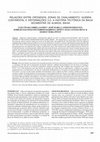
Revista Brasileira de Geociências
is a geometric out-pattern member in the group the onshore coastline sedimentary basins of the Ba... more is a geometric out-pattern member in the group the onshore coastline sedimentary basins of the Bahia State and neighborhoods. This basin differs from the traditional elongated-shape trending Camamú and Reconcavo-Tucano-Jatobá basins, and shows a compact rhombohedral arrangement following N45 o , N90 o , N120 o e N-S structural lineaments. This shape directly or indirectly reflects a specific geological history influenced by the paleoproterozoic and neoproterozoic orogens, neoproterozoic shear zones and mesozoic supercontinent break-up. Several sets of fault and fractures were kinematically studied inside and around the basin, and the main stress tensors obtained using inversion methods. The structural study of the Almada Basin allowed to recognize that: (i) the initial tectonic activity was controlled by normal faults, with orthorhombic-romboedral 3-D extensional strain pattern, followed by transtensional ones characterizing the Almada Basin as a polyphasic tectonic basin, and (ii) during the transtensive phase this basin was affected by at least two almost orthogonal extensional events, indicating a possible σ 1 orientation inversion during its formation and tectonic evolution. These data are crucial for prospecting groundwater and hydrocarbon in the basin onshore and offshore areas.
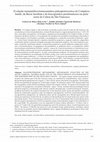
Revista Brasileira de Geociências
Resumo O Complexo Saúde e a Bacia Jacobina, localizados na parte norte do Cráton do São Francisco... more Resumo O Complexo Saúde e a Bacia Jacobina, localizados na parte norte do Cráton do São Francisco, são constituídos por rochas metassedimentares, metamorfizadas durante a orogenia paleoproterozóica (≈ 2,08-1,88 Ga) e associadas a leucogranitos. Os kinzigitos e paragnaisses não-granadíferos do Complexo Saúde, os xistos aluminosos da Bacia Jacobina e os leucogranitos são portadores de assembléias mineralógicas relacionadas à colisão orogênica. Nos kinzigitos, a granada, e nos paragnaisses, a estaurolita, associadas à sillimanita + quartzo + biotita foram formadas durante a trajetória metamórfica progressiva, enquanto cordierita e plagioclásio cristalizaram durante a trajetória retrógrada associada à descompressão orogênica. Nos xistos aluminosos, granada e estaurolita cristalizaram durante o metamorfismo progressivo, porém andaluzita e plagioclásio expressam o retrometamorfismo. Os paragnaisses não-granadíferos, os andaluzita-xistos e os leucogranitos contêm microestruturas constituídas por fibrolita + quartzo + muscovita. Essas microestruturas se formaram por circulação de fluidos redutores que lixiviaram principalmente cátions-base dos silicatos preexistentes, caracterizando metassomatismo ocorrido durante e/ ou após a descompressão orogênica. Os leucogranitos atuaram como motores termodinâmicos na mobilização dos fluidos crustais. Esse evento de metassomatismo foi responsável por inflexões quase isobáricas (≈ 3,0 kbar) nas trajetórias P-T regressivas dos paragnaisses não-granadíferos e dos xistos aluminosos, em direção a temperaturas próximas de 600 o C. Nos kinzigitos, a ausência de fibrolita e muscovita e as estimativas de geotermometria, entre as fácies granulito baixo e anfibolito alto, sugerem um posicionamento alóctone dessas rochas provenientes da infracrosta do orógeno.

Revista Brasileira de Geociências
GEOLOGY OF THE SOUTHERN SEGMENT OF THE ITABUNA-SALVADOR-CURAÇÁ OROGEN AND FIELD-TRIP GUIDE Geolog... more GEOLOGY OF THE SOUTHERN SEGMENT OF THE ITABUNA-SALVADOR-CURAÇÁ OROGEN AND FIELD-TRIP GUIDE Geological mapping, petrographic, petrochemical, tectonic, geochronological and isotopic studies that have been carried out on the poly-deformed Archean terranes of southern Bahia have discriminated different domains. To the western part (Jequié Block) there occur heterogeneous granulites, from igneous and metasedimentary origin (3.2-2.9Ga) besides enderbitic, charnoenderbitic and charnockitic rock units (2.8-2.7Ga), all of them exihibiting calc-alkaline chemical affinities, with high to intermediary potash contents. To the eastern part (Itabuna-Salvador-Curaçá Block), most of the rock units cropping out are metatonalites-metatrondhjemites (2.6-2.5Ga) and metamonzonites (2.4Ga), the first ones presenting calc-alkaline affinities with low potash and the last ones tending to a shonshonitic character. Both types display enclaves of gabbros and granulitized supracrustal rocks. Between the above mentioned blocks there is occurring a narrow belt of quartz-feldspatic rocks, besides some granites ("Band" of Ipiaú), all of them under the amphibolite facies of metamorphism. About 2.0-1.9Ga the collision of the two above-mentioned blocks have occurred. Such collision was responsible for the tectonic superposition of blocks and also for the granulitization processes of the southern part of the Itabuna-Salvador-Curaçá Block. Nevertheless, the "Band" of Ipiaú, positioned between the two blocks remained preserved in the amphibolite facies. During the peak of the metamorphism were generated leucocharnockites, garnet-cordierite bearing types, that have usually been considered of anatetic origin (metasediment derived) as well as charnockites formed by partial melting of the enclosing rocks, these latter usually exihibint very typical oval structures
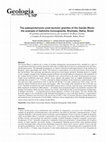
Geologia USP. Série Científica
The Gavião Block is underlain by a variety of Archean orthogneisses and greenstone belts, intrude... more The Gavião Block is underlain by a variety of Archean orthogneisses and greenstone belts, intruded by a suite of syn-deformational and post-tectonic granitoids which ages of emplacement are poorly constrained between the Paleoand Mesoproterozoic. The Salininha monzogranite is a massive intrusion located approximately 50 km northwest of Brumado, south-central Bahia state, Brazil. The intrusion is representative of several post-tectonic felsic plutons in the Gavião Block. Their petrology, geochemistry and age have been largely unstudied. Salininha pluton is a roughly 16 km2 irregular, elongate body intruding strongly deformed and metamorphosed orthogneisses and migmatites of the Archean Gavião Complex. Modally, the Salininha rocks contain biotite as the major ferromagnesian accessory, besides lesser hornblende, muscovite, chlorite, zircon, opaques and epidote. They are slightly peraluminous rocks with high silica contents (71.6 – 75.0wt%), obtained by lithium tetraborate fusion induct...
Uploads
Papers by Johildo Barbosa